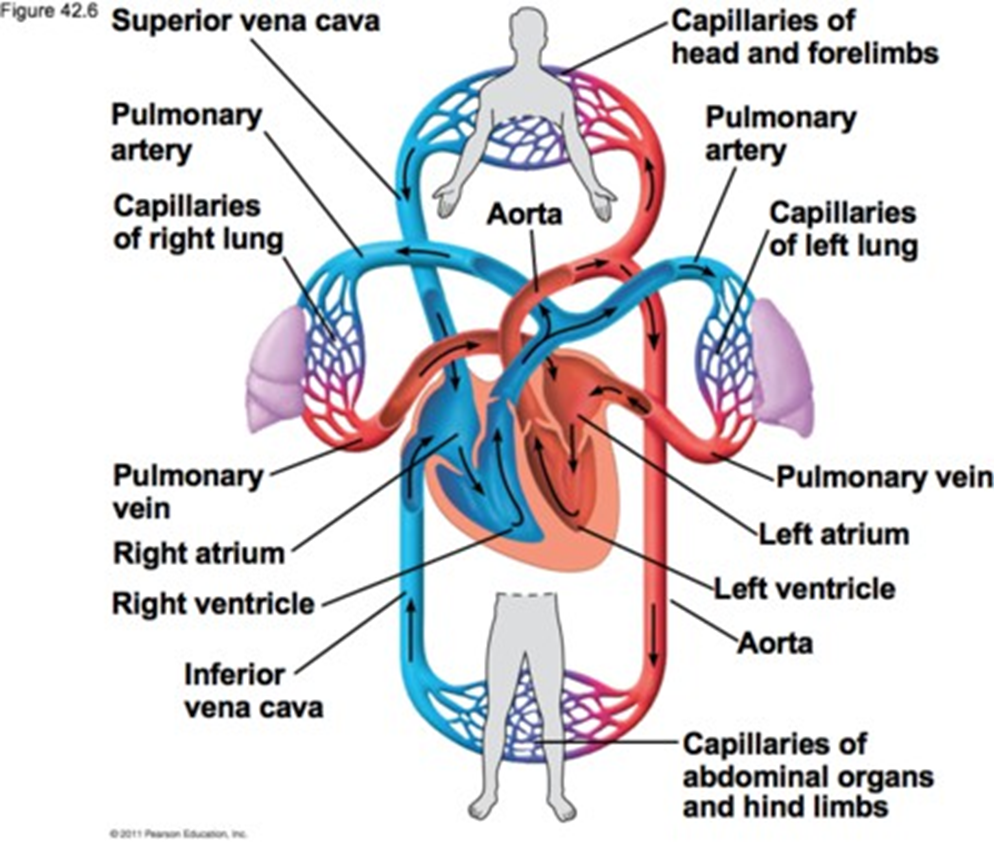Which sequence best describes the direction of blood flow through the heart and lungs?
Vena cava → Right atrium → Right ventricle → Lungs → Pulmonary artery → Left atrium → Left ventricle.
Right atrium → Right ventricle → Pulmonary vein → Lungs → Pulmonary artery → Left atrium → Left ventricle.
Right atrium → Right ventricle → Pulmonary artery → Lungs → Pulmonary vein → Left atrium → Left ventricle.
Right atrium → Right ventricle → Lungs → Pulmonary vein → Pulmonary artery → Left atrium → Left ventricle → Vena cava.
The Correct Answer is C
Choice A rationale
This sequence is incorrect because it suggests that blood goes from the lungs to the pulmonary artery, which is not accurate. The pulmonary artery carries deoxygenated blood from the heart to the lungs.
Choice B rationale
This sequence is incorrect because it suggests that blood goes from the pulmonary vein to the lungs, which is not accurate. The pulmonary vein carries oxygenated blood from the lungs to the heart.
Choice C rationale
This sequence correctly describes the direction of blood flow through the heart and lungs. Deoxygenated blood enters the right atrium, goes to the right ventricle, then is sent to the lungs via the pulmonary artery. After picking up oxygen in the lungs, the blood returns to the heart via the pulmonary vein, entering the left atrium, then the left ventricle, from where it is pumped out to the rest of the body.
Choice D rationale
This sequence is incorrect because it suggests that blood goes from the pulmonary vein to the pulmonary artery, which is not accurate. The pulmonary vein carries oxygenated blood from the lungs to the heart, and the pulmonary artery carries deoxygenated blood from the heart to the lungs.

Nursing Test Bank
Naxlex Comprehensive Predictor Exams
Related Questions
Correct Answer is B
Explanation
Choice A rationale
While dizziness after the first dose of captopril can be concerning, it is not uncommon as the body adjusts to the medication. It is important to monitor this patient, but they are not the highest priority.
Choice B rationale
A patient exhibiting new-onset confusion, restlessness, and cool, clammy skin should be prioritized for assessment. These symptoms could indicate a serious condition such as shock or decreased cardiac output. This patient may be experiencing a rapid decline in condition and should be assessed immediately.
Choice C rationale
While a patient on oxygen therapy with bilateral crackles at the lung bases may have worsening heart failure, they are not the highest priority if they are stable. Crackles at the lung bases are a common finding in heart failure and indicate fluid accumulation in the lungs.
Choice D rationale
A patient on IV nesiritide (Natrecor) with a blood pressure reading of 100/62 is not the highest priority. While this blood pressure is on the lower side, it is not critically low.
Nesiritide can cause hypotension, so this patient should be monitored, but they are not the highest priority if they are stable.
Correct Answer is C
Explanation
The patient with a blood pressure of 116/42 mm Hg has a mean arterial pressure (MAP) of approximately 67 mm Hg, which is less than the standard policy of 70 mm Hg. This could indicate inadequate blood flow to the vital organs, necessitating notification of the healthcare provider.
Whether you are a student looking to ace your exams or a practicing nurse seeking to enhance your expertise , our nursing education contents will empower you with the confidence and competence to make a difference in the lives of patients and become a respected leader in the healthcare field.
Visit Naxlex, invest in your future and unlock endless possibilities with our unparalleled nursing education contents today
Report Wrong Answer on the Current Question
Do you disagree with the answer? If yes, what is your expected answer? Explain.
Kindly be descriptive with the issue you are facing.
